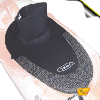Spray deck
A spraydeck (sprayskirt in N. America, akuilisaq or tuiitsoq in Greenland) is a flexible waterproof cover for a boat (in particular for a kayak or a canoe) with holes for the passengers' waists.
On a kayak, the spraydeck is secured to a rim surrounding the cockpit with a line or elastic string called a rand.
Alternatively elastic cord is attached directly to the edge of the spraydeck, and is tightened around the rim of the kayak's cockpit or stretched over it.
The fastening may be pulled tight or held so by its elasticity, this prevents water infiltration while allowing the kayaker to quickly release it if the boat should capsize: a so-called wet exit.
A properly sealed spraydeck will allow a kayaker to perform an eskimo roll and continue paddling without having to bail out.
Modern designs have many features for safety and convenience such as map and paddle pockets, access openings, and tie-down straps.
Like a kayak, a spray deck can help allow a canoeist to perform a roll (provided he/she is strapped to the canoe) and continue paddling without having to bail out.
During rainy, windy and or cold weather, it keeps the lower body of the canoeist drier, warmer, and helps prevent water from building up a puddle at the bottom of the boat.
This is made in the same way as the half-jacket, and, like it, fits close to the kayak-ring, but is longer above, has sleeves attached to it, and a hood that comes right over the head.
It is laced tight around the face and wrists, so that with it on the kaiak-man can go right through the breakers and can capsize and right himself again, without getting wet and without letting a drop of water into the kaiak.
—Fridtjof Nansen, "Eskimo Life", 1893, English translation by William Archer Sprayskirts (and tuiliks) can also be made of gut[3] from the intestines of sea mammals or bears.
Models designed for casual use to just prevent splashes from entering the craft will typically have light shock-cord, making them easy to fit.
Models designed for severe use such as for descending waterfalls are heavily elasticated so they remain in place, but require significant arm strength to fit.









